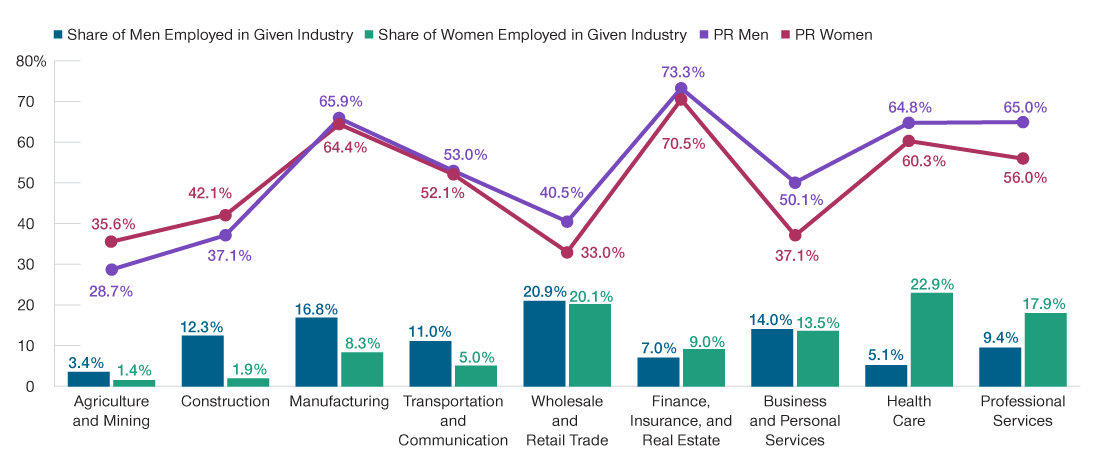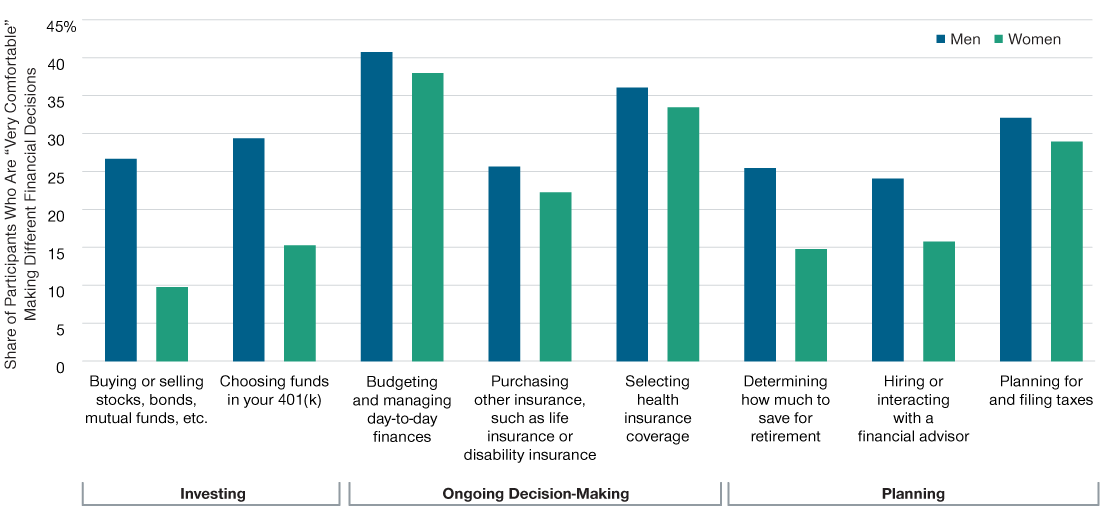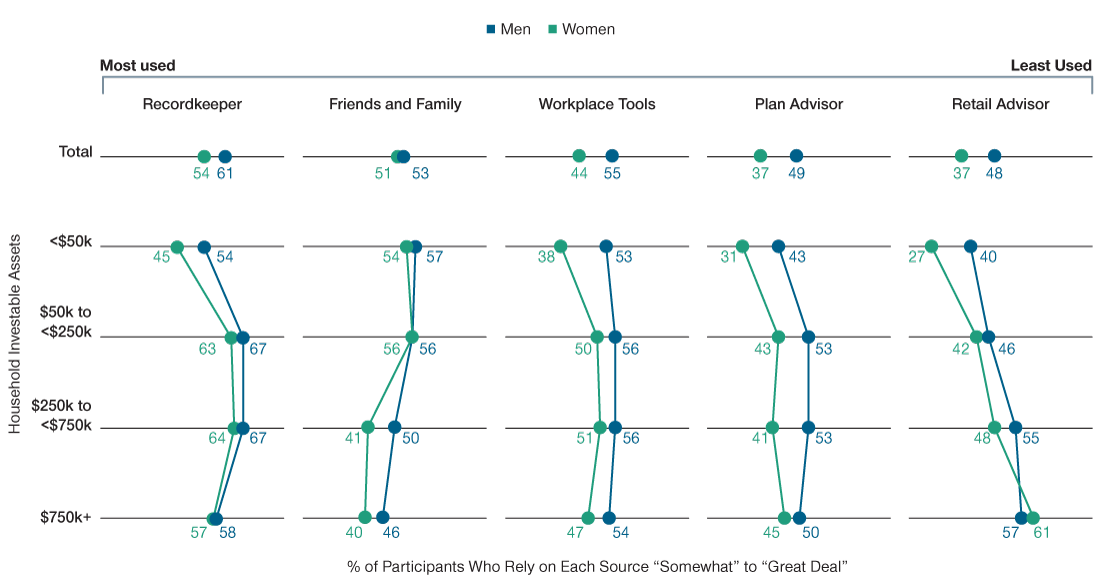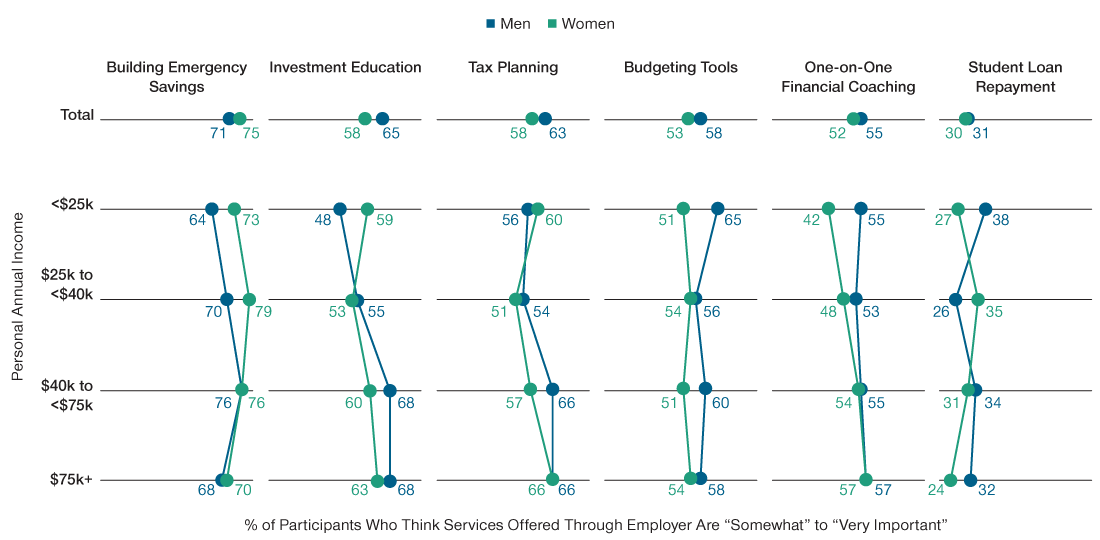- From the Field
- Closing the Gender Retirement Savings Gap
- Addressing barriers to retirement savings for women.
- 2023-03-13 20:11
- Key Insights
-
- While there is no gender gap in access to retirement plans, women lag far behind men in terms of contributions, savings, and retirement confidence.
- Typically lower incomes, higher debt loads—especially student loans—and shorter job tenures are some of the factors contributing to the gender savings gap.
- Employers and the retirement industry can help narrow this gap by ensuring that benefits programs, overall, can meet the needs of the female workforce.
For many employers, diversity and inclusion is an important area of focus, and inequities in their own retirement savings plans have gained renewed attention. To this end, some of the recent research, including ours, has focused on the racial gaps in retirement savings. But an equally important dimension of the retirement savings gap is gender.1 In 2022, our T. Rowe Price Retirement Savings and Spending Study, which surveys a nationally representative group of 401(k) participants, focused on the gender gap in retirement savings—and the disparities are striking.
The Gender Gap in Retirement Savings
(Fig. 1) For women, lower contributions mean less savings
| Men | Women | Gap | |
|---|---|---|---|
| Contribution* | $9,578 | $5,421 | ‑43% |
| Savings† | $62,040 | $21,638 | ‑65% |
| Confidence‡ | 37% | 22% | ‑40% |
Source: T. Rowe Price Retirement Savings and Spending Study, 2022.
*Estimated annual 401(k) contribution (median expected contribution % x median personal income).
† Median 401(k) balance.
‡ How confident are you about retirement (on a scale of 0 to 10)? Percentages based on top 3 boxes, those who rated their confidence levels at 8, 9, and 10.
No Gender Gap in Access to Retirement Plans
(Fig. 2) Retirement plan participation among 21–64 year old wage or salaried workers in the private sector.

Source: Author’s calculations from the Annual Social and Economic (ASEC) supplement of the Current Population Survey (CPS), 2022. IPUMS CPS, University of Minnesota.
Participation Rate = Share of total private sector workforce (with or without access to a retirement plan) who participate in a retirement plan.
Our analysis showed that women were contributing less annually to their workplace retirement accounts, and as a result, they had significantly lower retirement account balances (Figure 1). Notably, the median 401(k) account balance for women was 65% lower than for men. Therefore, it is understandable that women’s confidence levels in attaining retirement goals were also lower.
"...women’s confidence levels in attaining retirement goals were also lower."
The gender gap in retirement savings is a challenge for women who are preparing for retirement. We understand that there are various social and economic factors that significantly affect women’s ability to save. For the purposes of our paper, we only focus on factors that can be addressed by employers and other retirement industry stakeholders.
In our research, we examined how traditionally lower incomes, along with factors such as access to and participation in retirement plans, debt, and job tenure, may be contributing to the gender retirement savings gap. We believe that stakeholders in the retirement industry—including employers, recordkeepers, financial professionals, and policymakers—can learn from similar research to help narrow the gap.
No Gap in Retirement Plan Access and Participation
Interestingly, we found that there were no overall gaps in access to retirement plans between men and women. In fact, retirement plan participation appears consistent among private sector wage and salaried workers (Figure 2).
However, this apparent gender equality in participation masks disparities and wide variations in the level of participation across different industries (Figure 3). For example, wholesale and retail trade and business and personal services industries employ men and women equally. Despite this, the retirement plan participation rate is significantly lower among women in those industries.
Even in industries that employ significantly more women than men—such as health care and professional services—women still lag in their rate of retirement plan participation. This disparity in participation further exacerbates the gender savings gap, given the large population of women who work in these industries.
There are, however, some bright spots for women highlighted in the research. Although fewer women work in manufacturing and in transportation and communication, their retirement plan participation in these sectors is on par with that of their male peers. Compared with these industries, women in the finance, insurance, and real estate industries make up a larger share of the overall workforce, and the data show that their participation rate is close to that of their male colleagues.
Women in Several Industries Lag in Retirement Plan Participation
(Fig. 3) Retirement plan participation among 21–64 year old wage or salaried workers in the private sector across different industries

Source: Author’s calculations from the Annual Social and Economic (ASEC) supplement of the Current Population Survey (CPS), 2022. IPUMS CPS, University of Minnesota.
Participation Rate (PR) = Share of total private sector workforce (with or without access to a retirement plan) who participate in a retirement plan.
Lower Income Means Lower Contributions
Although many employers have made progress in addressing the gender pay gap, national averages reflect that women typically earn less than men. In our survey of plan participants, the median income of women was two‑thirds that of men (Figure 4). While the various factors behind this disparity are the subject of debate, the effect is unambiguous—women are less likely to be prepared for a secure retirement because lower income limits their ability to save.
But interestingly, our study found that at any given level of income, women are more likely to participate in retirement plans than men (Figure 5). In other words, absent any income disparities, women would, in fact, be more likely to save.
However, women’s rate of saving is lower. The expected median contribution rate for women, including both the employer and employee contribution, is 11%, compared with 13% for men. The 2% difference in the contribution rate seems marginal, but when coupled with a lower income base, the long‑term compounded effect can result in dramatically lower retirement account balances for women. In our study, the approximate median contribution for women was 43% less than for men and women’s median 401(k) balances were roughly one‑third of those of men.
Women Typically Earn Less Than Men
(Fig. 4) Despite some progress, a gender income gap still persists

Source: T. Rowe Price Retirement Savings and Spending Study, 2022. Shows median income.
Across Different Income Groups, Women Are More Likely to Save
(Fig. 5) Retirement plan participation among 21–64 year old wage or salaried workers in the private sector across different income groups

Source: Author’s calculations from the Annual Social and Economic (ASEC) supplement of the Current Population Survey (CPS), 2022. IPUMS CPS, University of Minnesota.
Participation Rate (PR) = Share of total private sector workforce (with or without access to a retirement plan) who participate in a retirement plan.
Women are more likely to take time out of the workforce when starting a family or for caregiving responsibilities. To manage competing priorities and gain flexibility, they may also alter their career paths or work reduced hours. This loss of income and retirement benefits—such as employer match contributions—and the disruption in plan participation can contribute to the gender retirement savings gap.
Lower Income Has Lead to Lower Contributions and, Eventually, to Lower Balances
(Fig. 6) The compounding impact of lower contributions is significant.

Source: T. Rowe Price Retirement Savings and Spending Study, 2022. Numbers shown are the medians.
Women Generally Have Shorter Job Tenures Than Men
(Fig. 7) Distribution of job tenure by gender

Source: T. Rowe Price Retirement Savings and Spending Study, 2022.
Shorter Job Tenures Can be an Impediment for Women
Relatedly, our research also shows that female participants have shorter job tenures (median of six years) than their male counterparts (median of eight years). In addition, only 10% of male participants have a tenure of one year or less compared with 17% of female participants.
Shorter tenures can result in lower retirement savings in a number of ways. Plans have varying vesting rules, and those without immediate vesting can deny some portion of employer contributions to employees with shorter tenures. Also, participants who change jobs after a short stint with an employer usually have smaller balances and might be more inclined to cash out their savings, even if that incurs a penalty. Additional research is needed to see if female participants are more likely to cash out.
Women Carry a Higher Debt Burden
For many participants, paying off debt is a high financial priority that competes with retirement saving. This is particularly true for women. Our analysis found that more women than men held debt across all categories except for home equity loans (Figure 8). The disparity in student loan debt, in particular, is staggering. Among the surveyed participants, 14% of men and 23% of women reported that they had student loan debt—a difference of 60%.
More Women Held Debt in Almost Every Category
(Fig. 8) Significantly more women than men had outstanding student loans

Source: T. Rowe Price Retirement Savings and Spending Study, 2022.
Women Had Higher Outstanding Student Loans
(Fig. 9) Student loan debt could be hampering women’s ability to save

Source: T. Rowe Price Retirement Savings and Spending Study, 2022.
Our analysis found that, except for those in Gen Z, women have higher outstanding student loan balances than their male peers (Figure 9). The outstanding balance increases progressively for millennials and Gen Xers before dropping for baby boomers. This could be partly because women tend to take out more in student loans and pay back less due to lower incomes.
The smaller payments and compounding interest charges on outstanding loan balances can increase loan balances over time, highlighting the need for assistance to those who are struggling with student loan debt. The recently passed SECURE 2.0 Act of 2022 (SECURE 2.0) legislation allows plan sponsors to adopt provisions that match student loan payments in terms of retirement contributions and could give a boost to retirement savers, particularly women.
Less Savings Results in Less Wealth
Given these trends, it is not surprising that women on average are also less wealthy than men. Indeed, our analysis found that roughly one in four female retirement plan participants has a negative net worth, as calculated by total investable assets plus home equity less debt. In comparison, just over one in 10 men reported a negative net worth (Figure 10).
Additional research is also needed to understand the impact of caregiving and child‑care costs on retirement savings, particularly for women. Generally, women are disproportionately responsible for unpaid caregiving of loved ones, often prioritizing those responsibilities ahead of their careers.
Vast Gender Gaps Remain in Overall Wealth
(Fig. 10) One in four female participants reported a negative net worth versus one in 10 men

Source: T. Rowe Price Retirement Savings and Spending Study, 2022.
An estimated 59% of women provide 20 hours or less of unpaid care per week compared with 41% of men. The difference between male and female caregivers providing more hours of unpaid care is much greater: 62% of women provide more than 20 hours of weekly care compared with 38% of men.2
In addition, according to the latest Census (2021),3 single parents make up more than one‑quarter of all American family groups raising children under the age of 18, and 80% of these single‑parent households are led by mothers. It is therefore reasonable to assume that the steep costs of raising children are making it even harder for women in this demographic to adequately save for retirement.
How Can We Move the Needle?
To understand how we can help women close the savings gap, we asked them what challenges they face when it comes to saving and investing. While women are almost as comfortable as men making daily financial decisions, they are less comfortable making longer‑term financial planning decisions, particularly investment choices (Figure 11).
The disparity in women’s comfort level when selecting investments in a retirement plan account and determining how much to save for retirement was notable. This lack of confidence is problematic and could lead to actions that hamper successful retirement outcomes, such as under‑saving, untimely withdrawals, investing too conservatively, or other mistakes.
Some past studies have suggested that men and women might have different levels of risk tolerance and might invest differently. But to understand the differences in investing patterns of men and women in the age of auto‑enrollment and qualified default investment alternatives (QDIAs), we need more careful analysis of participant investment behavior. All stakeholders—including plan sponsors, recordkeepers, and financial professionals—could then help female investors work toward their retirement goals.
Women Are Less Comfortable Making Investment Decisions
(Fig. 11) Confidence in making longer‑term financial decisions could prevent actions that hamper successful retirement outcomes

Source: T. Rowe Price Retirement Savings and Spending Study, 2022.
Our research also found that women, particularly those with fewer assets, are less likely to hire or interact with a financial professional for help navigating their retirement journey. The least wealthy female participants—those with under $50,000 in household investable assets—were also less inclined to leverage workplace advice resources and mostly relied on guidance from friends and family (Figure 12). This could be an opportunity for plan sponsors and recordkeepers to promote the financial tools and resources. Promotional messages can help with participant engagement by making the tools and resources accessible, user‑friendly, and less intimidating.
We also found that the financial needs of women are not uniform, and they value different employer‑provided products and services (Figure 13). Generally, women earning less than $40,000 had a higher need for products and services that help them with building emergency savings, investment education, and student loan repayment. At higher income levels, the preference for these employer‑provided tools and services did not vary significantly between genders.
Overall, the workplace remains an important source of advice for retirement savers. We believe that this provides a great opportunity for employers and recordkeepers to engage with women and provide guidance that can help to improve the financial wellness for female participants who may be reticent about seeking guidance.
Women Engaged Less With Plan‑Provided Resources
(Fig. 12) The least wealthy women were less likely to leverage workplace financial tools and resources

Source: T. Rowe Price Retirement Savings and Spending Study, 2022.
Women’s Financial Needs Are Not Uniform
(Fig. 13) Income influenced what products and services women wanted from their employers

Source: T. Rowe Price Retirement Savings and Spending Study, 2022.
What Can Employers and Financial Professionals Do to Close the Gap?
To be sure, the savings gap between men and women is attributable to various complex factors, which may not be completely addressed by employers or financial professionals. But these stakeholders can help narrow the gap by addressing the unique needs of the female workforce.
Statistically, women are more likely to live longer than their male counterparts, more likely to take on unpaid caregiving, and they typically share more responsibilities of child rearing. By understanding these unique needs, recordkeepers, plan sponsors, and financial professionals can help women become more comfortable with financial decisions and take actions to help to close the gender savings gap.
Design Benefit Programs to “Lift All Boats”
Adoption of auto‑features such as auto‑enrollment, auto‑reenrollment, auto‑escalation, and QDIAs could nudge all employees into saving more and help women, in particular, increase contribution rates and gain comfort in their investment decisions. Innovations such as out‑of‑plan emergency savings or debt management programs could help boost retirement savings for women. Similar in‑plan innovations such as matching retirement contributions for student loan debt repayments or setting up an emergency savings program to prevent untimely withdrawal of retirement savings are also now possible due to the recently passed SECURE 2.0 legislation.
Bolster Financial IQ to Improve Behavior
Our research shows that the workplace remains the primary source for accessing educational tools and financial guidance. Employers enjoy a unique trust, which could be utilized to deliver personalized communications or interventions that help employees understand the consequences of their actions, such as lowering or stopping contributions or taking loans, while encouraging them to build up emergency savings, pay down high‑interest loans, and start saving early for retirement.
Use Plan Data and Research to Improve Outcomes
Employers should focus more on analyzing plan data to understand their participants’ behavior and who is falling behind. If the data are available, this could include analyzing the savings behavior of different segments of participants, such as women, racial minorities, different income groups, and so on. Employers could also compare their participants’ savings with industry or national benchmarks. This will not only give them a better idea about where their participants stand but could also provide some guidance about their competitiveness as an employer.
Utilize Platforms Outside of Retirement Plans to Foster Organic Discussions
These days, many companies, particularly the larger ones, have business resource groups (BRGs) formed around employees’ personal interests or characteristics. Moreover, many firms have BRGs focused on challenges facing women in the workplace. Having retirement preparation conversations under the umbrella of BRGs could be very useful. BRGs can drive less formal and more personal discussions, which can often give employers ideas about what their employees are struggling with and how to help them. They can also be used to promote the underutilized financial tools and services that the employers provide as voluntary benefits. Suggestions coming from fellow coworkers could make an impactful difference.
Get insights from our experts.
Subscribe to get email updates including article recommendations relating to retirement.
-
1 Participants in the survey self‑identified their gender. For the purposes of this research, we use the term woman to refer to an adult who lives and identifies as a female and the term man to refer to an adult who lives and identifies as a male.
2 Amy Barger and Christina Best, “The State of Women and Caregiving.” https://www.caregiving.com/posts/women‑and-caregiving‑2021
3 United States Census Bureau. 2021. America’s Families and Living Arrangements: 2021.
Retirement Savings and Spending Study
The Retirement Savings and Spending Study is a nationally representative online survey of 401(k) plan participants and retirees. The survey has been fielded annually since 2014. The 2022 survey was conducted between June 24 and July 22. It included 3,895 401(k) participants, full‑time or part‑time workers who never retired, currently age 18 or older, and either contributing to a 401(k) plan or eligible to contribute and have a balance of $1,000+. The survey also included 1,136 retirees who have retired with a Rollover IRA or left‑in‑plan 401(k) balance. NMG Consulting conducts this annual survey on behalf of T. Rowe Price.
This research is a continuation of the first theme of Access and Adequacy that is discussed in our 2023 Retirement Market Outlook. This theme focuses on who under‑saves and why, as well as who can help and how. For more details, our retirement market outlook can be accessed here: https://www.troweprice.com/retirement-plan-services/en/insights/retirement-market-outlook.html
-
Important Information
This material is provided for general and educational purposes only and is not intended to provide legal, tax, or investment advice. This material does not provide recommendations concerning investments, investment strategies, or account types; it is not individualized to the needs of any specific investor and not intended to suggest any particular investment action is appropriate for you, nor is it intended to serve as the primary basis for investment decision‑making.
Any tax‑related discussion contained in this material, including any attachments/links, is not intended or written to be used, and cannot be used, for the purpose of (i) avoiding any tax penalties or (ii) promoting, marketing, or recommending to any other party any transaction or matter addressed herein. Please consult your independent legal counsel and/or tax professional regarding any legal or tax issues raised in this material.
The views contained herein are as of the date written and are subject to change without notice; these views may differ from those of other T. Rowe Price associates.
This information is not intended to reflect a current or past recommendation concerning investments, investment strategies, or account types, advice of any kind, or a solicitation of an offer to buy or sell any securities or investment services. The opinions and commentary provided do not take into account the investment objectives or financial situation of any particular investor or class of investor. Please consider your own circumstances before making an investment decision.
Information contained herein is based upon sources we consider to be reliable; we do not, however, guarantee its accuracy.
Past performance is not a reliable indicator of future performance. All investments are subject to market risk, including the possible loss of principal. All charts and tables are shown for illustrative purposes only.
T. Rowe Price Investment Services, Inc., distributor, and T. Rowe Price Associates, Inc., investment adviser.
© 2024 T. Rowe Price. All Rights Reserved. T. Rowe Price, INVEST WITH CONFIDENCE, and the Bighorn Sheep design are, collectively and/or apart, trademarks of T. Rowe Price Group, Inc. RETIRE WITH CONFIDENCE is a trademark of T. Rowe Price Group, Inc.
202403-3462945